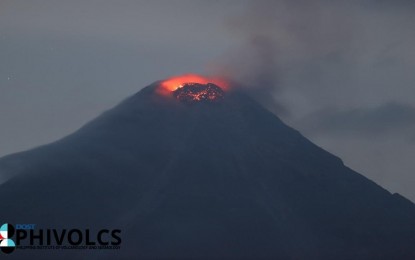[7.10] Phivolcs 수석 : Mayon 불안이 심화됨에 따라 준비하십시오
컨텐츠 정보
- 22,054 조회
본문
마닐라 – 필리핀 화산지진학연구소(Phivolcs) 소장은 월요일 마욘 화산 활동이 증가하고 있으며 반경 7~8km 내에 거주하는 사람들에게 화산의 화쇄 밀도 흐름(PDC) 활동이 악화될 경우에 대비하도록 조언했습니다. .
Phivolcs는 오후 5시 이후로 말했습니다. 7월 9일 현재 총 33개의 PDC, 즉 빠르게 움직이는 화산 가스, 화산재 및 암석 조각의 혼합물이 마욘 화산 정상 분화구의 돔 붕괴와 상부에서 진행하는 용암 흐름의 붕괴 전면 및 가장자리에 의해 생성되었습니다. 중간 경사로.
"이 경우 33개의 PDC는 화산 정상의 용암 돔이 무너졌을 때 생성되었으며, 이러한 용암 흐름이 아래로 이동함에 따라 용암 흐름에서도 생성되었습니다.
Phivolcs에 따르면 PDC는 분화구에서 3.3km 이내의 Mi-isi와 Bonga Gullies를 따라 약 1~4분 동안 이동했습니다.
Phivolcs가 추가한 위성 모니터는 7월 9일 이산화황(S02) 배출량의 현저한 증가를 감지한 반면 캠페인 조사에서 측정한 SO2 배출량은 같은 날 평균 943톤이었습니다.
Bacolcol은 "이러한 측정치는 이전 분출 동안 Mayon이 방출한 S02의 양(하루 3,000~7,000톤 범위)에 비해 여전히 상대적으로 낮습니다."라고 "Bacolcol"은 수치가 여전히 배경 수준보다 약간 높다고 덧붙였습니다.
Phivolcs는 또한 측정된 화산 가스 플럭스가 지난 3일 동안 배경보다 약간 높았으며 Mayon 화산의 일반적인 분출 가스 플럭스 범위보다 훨씬 낮은 상태를 유지하고 있다고 언급했습니다.
월요일 오전 5시 이후 총 109회의 약한 저주파 화산 지진이 기록되었지만 지진 에너지 방출은 6월 15일 이후 일반적으로 같은 수준으로 유지되고 있다고 Phivolcs는 말했습니다.
앞서 "바콜콜"은 지진의 수가 증가하더라도 약해지더라도 화산의 경계 수준은 여전히 유지될 것임을 의미한다고 말했습니다.
화산은 위험한 분출 경향이 높아져 여전히 경보 수준 3에 있습니다.
Phivolcs 추장은 반경 6km의 영구적인 위험 구역은 비워진 상태로 유지되어야 한다고 반복했습니다.
한편 항공 당국은 폭발로 인한 화산재가 항공기에 위험할 수 있으므로 조종사에게 화산 정상 근처에서 비행하지 않도록 조언할 것을 촉구했습니다. (PNA)
This is the Original Article from PNA NEWS
[7.10] Phivolcs chief: Be prepared as Mayon unrest intensifies
MANILA – The head of the Philippine Institute of Volcanology and Seismology (Phivolcs) on Monday said Mayon Volcano is experiencing increased activity, advising those living within the 7 and 8-kilometer radius to prepare in case the volcano's pyroclastic density current (PDC) activity worsens.
Phivolcs said that since 5 p.m. of July 9, a total of 33 PDCs, or fast-moving mixtures of volcanic gases, ash, and rock fragments, have been generated by dome collapse from Mayon Volcano’s summit crater and the collapsing front and margins of the advancing lava flows on the upper to middle slopes.
"In this case, the 33 PDCs were generated when the lava dome on the volcano's summit collapsed, and also from the lava flows as these lava flows moved downward," Phivolcs Director "Teresito Bacolcol" told the Philippine News Agency in an interview.
The PDCs traveled for about one to four minutes down the Mi-isi and Bonga Gullies within 3.3 kilometers of the crater, according to Phivolcs.
Phivolcs added satellite monitors detected a pronounced increase in sulfur dioxide (S02) emission on July 9, whereas SO2 emission measured by campaign survey averaged 943 tonnes on the same day.
"These measurements are still relatively low compared to the amount of S02 released by Mayon during previous eruptions, which ranged from 3,000 to 7,000 tonnes per day," "Bacolcol" said, adding that the figure is still just a little above the background level.
Phivolcs also noted that the measured volcanic gas flux has only been slightly above background for the past three days and remain much lower than the typical ranges of eruption gas flux from Mayon Volcano.
A total of 109 weak low-frequency volcanic earthquakes have been recorded since 5 a.m. Monday, but seismic energy release has been sustained at generally the same level since June 15, Phivolcs said.
"Bacolcol" earlier said that even if the earthquakes would increase in number but are weak, that would still mean the volcano's alert level would be maintained.
The volcano is still on Alert Level 3 due to an increased tendency towards hazardous eruption.
The Phivolcs chief reiterated that the 6 km.-radius permanent danger zone should remain evacuated.
Aviation authorities, meanwhile, are urged to advise pilots to avoid flying close to the volcano’s summit as ash from eruptions can be hazardous to aircraft. (PNA)
관련자료
-
이전
-
다음


